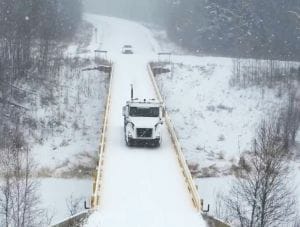
Autonomous vehicles use automated driving systems composed of advanced sensors, algorithms, hardware, and software to partially or entirely conduct driving functions without human input or intervention. FPInnovations’ initiative focuses on adapting existing autonomous solutions to meet the needs of the forest industry.
Over the past years, the FPInnovations team, in collaboration with technology providers, has tested semi-autonomous platooning trucks on paved test tracks and class 1 and 2 gravel forest roads. These tests focused on executing specific scenarios such as following a planned itinerary without human intervention, carrying out lane changes, and evaluating the follower vehicle’s reaction during vehicle cut ins. The team is now aiming to partner with a new technology provider to evaluate the performance of a single autonomous class 8 truck, demonstrating SAE level 2 autonomy on paved and gravel Quebec roads in winter conditions with a safety driver present.1 The program will employ a step-by-step gradual approach starting with the autonomous truck driving bobtail (without a trailer), progressing to empty trailer runs, followed by loaded trailer test runs and actual material deliveries.
In collaboration with two FPInnovations members, this year’s test program will see an autonomous truck delivering actual loads of chip and bark from point A to point B, allowing for real-life evaluation of how autonomy can be integrated into daily forest operations. The test team will evaluate operational efficiency gains through autonomous operations by tracking the number of loads delivered and conducting a fuel consumption comparison between manual and autonomous driving. Additional metrics such as the number of kilometres travelled in autonomous mode, number of system / sensor faults, and compliance with traffic laws will also be tracked.
It is clear that autonomy is on the horizon, and this test program will bring the forest industry one step closer to proving its applications in forest operations.
—–
1 The Society of Automotive Engineers (SAE) defines 6 levels of driving automation ranging from 0 (fully manual) to 5 (fully autonomous).





